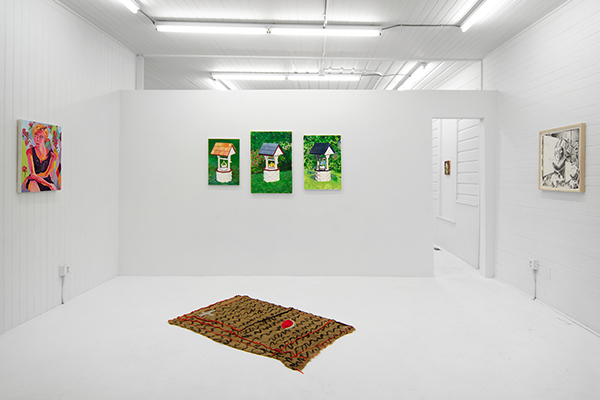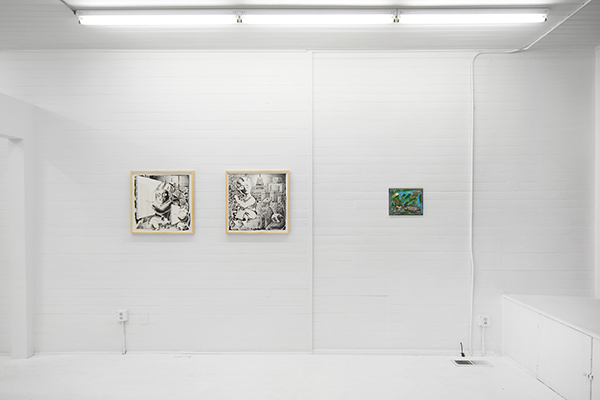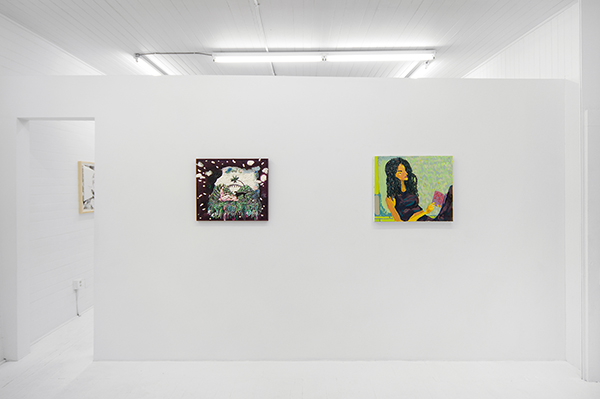











Maraschino
Curated by Adrianne Rubenstein
Alex Chaves
Josh Mannis
Annelie McKenzie
Nolan Simon
March 13 – April 12, 2015
Maraschino Cherry. To mix, first pick a bushel of cherries. It doesn’t matter what color they are. Forget the broccoli. Mix the cherries after washing them in a vat of water with sugar. Melt the sugar into the water; pour liberally from a bottle of alcohol into the pot. The kind of alcohol you use only a splash of in other recipes. Stir the pot with a wooden spoon. Heat the cherries. Add the dye. Bottle the cherries, seeds out. Close and deliver. Lasts one thousand years.
Maraschino cherries are preserves that recall a nuclear era. Like cat food in tins, or astronaut’s ice cream, they are the garnish on an otherwise simplistic covering for emotional whereabouts. The cherry with its stem leaning over the glass, the glass with its pattern of snowflakes or concentric diamonds, the ice cubes floating in the liquid like crystal vessels. The cherry is atomic. It’s a lipstick. It’s the detonator. Devoid of taste, watered out by goopy syrup, the flesh sustains color and form without relation to its genealogy.
Maraschino: Alex Chaves, Josh Mannis, Annelie McKenzie and Nolan Simon. Whether or not there are jokey paintings, in an art world, or serious paintings made by scribes in a frat house or anarchy, the paintings themselves tell stories. We understand these paintings only by getting on the level of the purveyor; the artist as mystic. Places where you can find an artist: on the floor, in the crook of a rock, in the studio, behind the music, after an avalanche. Artists are paying attention. The works in this exhibition belie a sense of individuality and superstition. Those who made them are using painting as a bottle for future messages. The social critique is like a deflated tall ship making its way peculiarly through a narrow opening.
- Adrianne Rubenstein, March 2015.
Curated by Adrianne Rubenstein
Alex Chaves
Josh Mannis
Annelie McKenzie
Nolan Simon
March 13 – April 12, 2015
Maraschino Cherry. To mix, first pick a bushel of cherries. It doesn’t matter what color they are. Forget the broccoli. Mix the cherries after washing them in a vat of water with sugar. Melt the sugar into the water; pour liberally from a bottle of alcohol into the pot. The kind of alcohol you use only a splash of in other recipes. Stir the pot with a wooden spoon. Heat the cherries. Add the dye. Bottle the cherries, seeds out. Close and deliver. Lasts one thousand years.
Maraschino cherries are preserves that recall a nuclear era. Like cat food in tins, or astronaut’s ice cream, they are the garnish on an otherwise simplistic covering for emotional whereabouts. The cherry with its stem leaning over the glass, the glass with its pattern of snowflakes or concentric diamonds, the ice cubes floating in the liquid like crystal vessels. The cherry is atomic. It’s a lipstick. It’s the detonator. Devoid of taste, watered out by goopy syrup, the flesh sustains color and form without relation to its genealogy.
Maraschino: Alex Chaves, Josh Mannis, Annelie McKenzie and Nolan Simon. Whether or not there are jokey paintings, in an art world, or serious paintings made by scribes in a frat house or anarchy, the paintings themselves tell stories. We understand these paintings only by getting on the level of the purveyor; the artist as mystic. Places where you can find an artist: on the floor, in the crook of a rock, in the studio, behind the music, after an avalanche. Artists are paying attention. The works in this exhibition belie a sense of individuality and superstition. Those who made them are using painting as a bottle for future messages. The social critique is like a deflated tall ship making its way peculiarly through a narrow opening.
- Adrianne Rubenstein, March 2015.